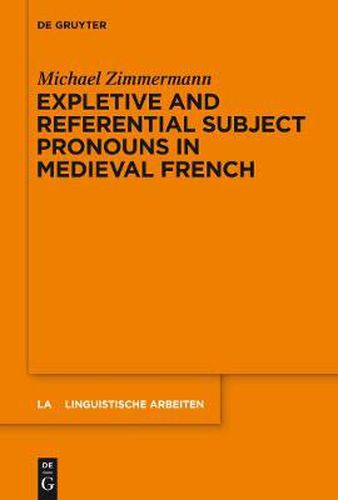Readings Newsletter
Become a Readings Member to make your shopping experience even easier.
Sign in or sign up for free!
You’re not far away from qualifying for FREE standard shipping within Australia
You’ve qualified for FREE standard shipping within Australia
The cart is loading…






This title is printed to order. This book may have been self-published. If so, we cannot guarantee the quality of the content. In the main most books will have gone through the editing process however some may not. We therefore suggest that you be aware of this before ordering this book. If in doubt check either the author or publisher’s details as we are unable to accept any returns unless they are faulty. Please contact us if you have any questions.
Medieval French, usually analyzed as a null subject language, differs considerably from modern Romance null subject languages such as Spanish in the availability of non-expressed subject pronouns; specifically, it shows characteristics reminiscent of non-null, rather than null subject languages, such as the expression of expletive subject pronouns. The central goal of this book is to put forward an account of these differences. On the basis of the analysis of an extensive, newly established data corpus, the development of the expression of both expletive and referential subject pronouns until the 17th c. is determined. Following a thorough discussion of previous approaches, an alternative approach is presented which builds on the analysis of Medieval French as a non-null subject language. The non-expression of subject pronouns, licit in specific contexts in non-null subject languages, is shown to be restricted to configurations generally involving left-peripheral focalization. These configurations - and, concomitantly, non-expressed subject pronouns - are finally argued to be eventually lost for good in the wake of the initial observation by 17th c. writers of pertinent instructions campaigned for in highly influential works of language use.
$9.00 standard shipping within Australia
FREE standard shipping within Australia for orders over $100.00
Express & International shipping calculated at checkout
This title is printed to order. This book may have been self-published. If so, we cannot guarantee the quality of the content. In the main most books will have gone through the editing process however some may not. We therefore suggest that you be aware of this before ordering this book. If in doubt check either the author or publisher’s details as we are unable to accept any returns unless they are faulty. Please contact us if you have any questions.
Medieval French, usually analyzed as a null subject language, differs considerably from modern Romance null subject languages such as Spanish in the availability of non-expressed subject pronouns; specifically, it shows characteristics reminiscent of non-null, rather than null subject languages, such as the expression of expletive subject pronouns. The central goal of this book is to put forward an account of these differences. On the basis of the analysis of an extensive, newly established data corpus, the development of the expression of both expletive and referential subject pronouns until the 17th c. is determined. Following a thorough discussion of previous approaches, an alternative approach is presented which builds on the analysis of Medieval French as a non-null subject language. The non-expression of subject pronouns, licit in specific contexts in non-null subject languages, is shown to be restricted to configurations generally involving left-peripheral focalization. These configurations - and, concomitantly, non-expressed subject pronouns - are finally argued to be eventually lost for good in the wake of the initial observation by 17th c. writers of pertinent instructions campaigned for in highly influential works of language use.